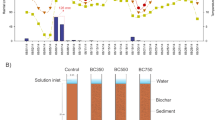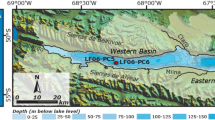Abstract
Mn, Sr, Ba, Rb, Cu, Zn, Pb and Cd concentrations have been measured seasonally in the water and deposited sediments of the system comprising: Zala river (main input) — Lakes Kis-Balaton 1 and 2 (small artificial lakes created in a former bay of Lake Balaton) — Keszthely bay (hypertrophic part of Lake Balaton). The concentrations of the trace elements together with pH, alkalinity, dissolved cations (Ca2+, Mg2+, Na+, and K+), dissolved inorganic ligands (Cl−, SO4 2−), particulate Al, Ca, inorganic and organic carbon are used to assess the contamination of the study area and biogeochemical processes controlling trace element concentrations. Thermodynamic speciation calculations have also been utilized to enhance our understanding of the system. In the sediments Rb, Ba, Cu and Zn concentrations were mainly controlled by the abundance of the aluminosilicate fraction. Strontium was mainly associated with the calcium carbonate fraction. The aluminosilicate fraction constitutes a major sink for Mn and Cd but the concentration of these elements are also strongly related to calcite precipitation. The main processes that control the dissolved distribution of trace elements in the Balaton system were: solid phase formation (carbonate) for Mn; coprecipitation with calcite for Sr, Ba, Rb and possibly Mn and Cd; adsorption/desorption processes (pH dependent) for Zn and Pb; solubilization of Mn and precipitation of Cd and Cu in reed covered wetland areas where anoxic conditions were probably existing during the warm season. A preliminary budget of atmospheric and river input to Lake Balaton has also been outlined. Although Lake Balaton, is subjected to anthropogenic inputs mainly from agricultural and domestic activities, their impact on trace element concentrations in the Balaton system is very limited due to the efficiency of removal processes (i.e. adsorption and co-precipitation) and to high sedimentation rates and strong sediment re-suspension. Anthropogenic inputs are only detected for Pb.
Similar content being viewed by others
References
Balistieri L. S., Murray J. W. and Paul, D. (1992) The hydrogeochemical cycling of trace metals in the water column of Lake Sammamish, Washington: response to seasonally anoxic conditions. Limnol. Oceanogr. 37, 529–548.
Balistieri L. S., Murray J. W. and Paul D. (1994) The geochemical cycling of trace elements in a biogenic meromictic lake. Geochim. Cosmochim. Acta 58(19), 3993–4008.
Benoit G. (1994) Clean techniques measurements of Pb, Ag and Cd in an industrialized river: a redefinition of metal pollution. Environ. Sci. Technol. 28, 1987–1991.
Boyle E. A. and Huested S. (1983) Aspects of the surface distribution of Cu, Ni, Cd and Pb in the North Atlantic and North Pacific. In Trace Metals in Seawater (eds. Wong et al.) Proceedings of NATO Advanced Research Institute on Trace Metals in Seawater, Erice, Italy, Plenum Press, pp.379–393.
Boyle E. A., Sclater F. R. and Edmond, J. (1977) The distribution of dissolved Cu in the Pacific. Earth Planet. Sci. Lett. 37, 58–54.
Bruland K. W. (1980) Oceanographic distributions of Cd, Zn, Ni and Cu in the North Pacific. Earth Planet. Sci. Lett. 47, 176–198.
Coale K. H. and Bruland K. W. (1988) Copper complexation in the Northeast Pacific. Limnol. Oceanogr. 33, 1084–1101.
Elbaz-Poulichet F., Garnier J. M., Guan D. M., Martin J. M. and Thomas A. J. (1996) The conservative behaviour of trace metals (As, Cd, Cu, Ni and Pb) in the surface plume of stratified estuaries: example of the Rhône river France. Est. Coast. Shelf Sci. 42, 289–310.
Falkner K., Measures C., Herbelin S. Edmond J. and Weis R. (1991) The major and minor geochemistry of Lake Baikal. Limnol. Oceanogr. 36(3), 413–423.
Garnier J. M., Martin J. M., Mouchel J. M. and Thomas A. J. (1991) Surface reactivity of the Rhone suspended matter and relation with trace element sorption. Mar. Chem. 36, 267–289.
Kozar S., Bilinski H. and Branica M. (1992) Adsorption of Pb and Cd ions on calcite in the Krka estuary. Mar. Chem. 40, 215–230.
Hanson A. K., Sakamoto-Arnold C. M., Huitzenga D. M. and Kester D. R. (1988) Copper complexation in the Sargasso Sea and Gulf Stream warmcore ring waters. Mar. Chem. 20, 299–312.
Herodeck S. (1977) Recent results on phytoplankton research in Lake Balaton. Annal. Biol. Tihany 44, 181–198.
Lorens R. (1981) Sr, Cd, Mn and Co distribution coefficients in calcite as a function of calcite precipitation rates. Geochim. Cosmochim. Acta 45, 553–561.
Meece D. and Benninger L. (1993) The coprecipitation of Pu and other radionuclides with CaCO3. Geochim. Cosmochim. Acta 57, 1447–1458.
Migon C., Nicholas M. and Journel B. (1995) Réevaluation des flux atmosphériques de métaux traces en Mer Ligure. Rapport Commission Internationale sur la Mer Méditerranée 34, pp 63.
Muller G. (1981) Heavy metals and nutrients in sediments of Lake Balaton, Hungary. Environmental Technology Letters 2, 39–48.
Patterson C. C. and Settle D. (1976) The reduction of orders of magnitude errors in lead analysis of biological materials and natural waters by evaluating and controlling the extent and sources of indudtrial lead contamination introduced during sample collecting, handling and analysis. Natl. Bur. Standards, Spec. Pub. 422, 321-351.
Ravichandran M., Baskaran M., Santshi P. and Bianchi T. (1995) History of trace metal pollution in Sabine-Neches Estuary, Beaumont, Texas. Environ. Sci. Technol. 29, 1495–1503.
Salanki J., Licsko I., Lasiao F., Balogh K. V., Varanka I. and Mastala Z. (1992) Changes in the concentration of heavy metals in the Zala Minor Balaton-Zala system (Water, Sediment, Aquatic life). Wat. Sci. Tech. 25(11), 173–180.
Schaule B. and Patterson C. C. (1983) Perturbation of the natural Pb depth profile in the Sargasso Sea by industrial Pb. In Trace Metals in Seawater (eds. Wong et al.), Proceedings of NATO Advanced Research Institute on Trace Metals in Seawater, Erice, Italy, Plenum Press, pp. 487–503.
Schecker W. D. and McAvoy D. C. (1992) MINEQL+, a software environment for chemical equilibrium modeling. Comput. Environ. and Urban Systems 16, 65–76.
Shiller A. M. and Boyle E. A. (1985) Dissolved Zn in rivers. Nature 317, 49–52.
Scholkovitz E. R. and Copland D. (1982) The chemistry of suspended matter in Esthwaite Water, a biologically productive lake with a seasonally anoxic hypolimnion. Geochim. Cosmochim. Acta 46, 393–410.
Sigg L., Sturm M., Stumm W., Mart L. and Nurnberg H. W. (1982) Schwermetalle im Bodensee. Mechanismen der Konzentrationsregulierung. Naturwissenschaften 69, 546–547.
Sigg L., Sturm M. and Kistler D. (1987) Vertical transport of heavy metals by settling particles in Lake Zürich. Limnol. Oceanogr. 32(1), 112–130.
Sigg L., Kistler D. and Ulrich M. (1996) Seasonal variations of Zinc in an eutrophic lake. Aquatic Chemistry 1, 313–328.
Stumm W. and Morgan J. (1981) Aquatic Chemistry, 2nd edition. Wiley Interscience, New York.
Viollier E., Jezequel D., Michard G., Pepe M., Sarazin G. and Alberic P. (1995) Geochemical study of a crater lake (Pavin Lake, France): Trace-element behaviour in the monimolimnion. Chemical Geology 125, 61–72.
Wartel M., Skiker M., Auger Y., Boughriet A., Puskaric E. and Guegueniat P. (1991) Seasonal variations of Mn2+ adsorption onto calcareous surfaces in the English Channel and its implication on the Mn-distribution coefficient. Mar. Chem. 36, 85–105.
Wollast R. and Vanderborght J. P. (1994) Aquatic carbonate systems: chemical processes in natural waters and global cycles. In Chemistry of Aquatic Systems: Local and Global Perspectives, (eds. G. Bodigliano and W. Stumm), Kluwer Academic Publishers, London.
Xue H. and Sigg L. (1993) Free cupric ion concentration and Cu(II) speciation in a eutrophic lake. Limnol. Oceanogr. 38(6), 1200–1213.
Author information
Authors and Affiliations
Rights and permissions
About this article
Cite this article
Elbaz-Poulichet, F., Nagy, A., Cserny, T. et al. Biogeochemistry of trace metals (Mn, Sr, Rb, Ba, Cu, Zn, Pb and Cd) in a river-wetland-lake system (Balaton Region, Hungary). Aquat Geochem 2, 379–402 (1996). https://doi.org/10.1007/BF00115978
Accepted:
Issue Date:
DOI: https://doi.org/10.1007/BF00115978




